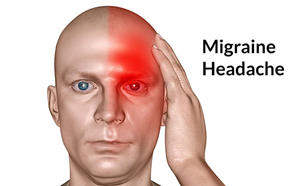
Migraine headache is a result of specific changes within the brain. It causes severe head pain that is often accompanied by sensitivity to light, sound, or smells.
Common symptoms include:
- Eye pain
- Sensitivity to light or sound
- Nausea
- Vomiting
- Severe pain, usually on one side of the head that some individuals describe as “pounding”
Other types of headaches can also cause severe pain, and not all headaches are migraines. For example, some people describe the pain of cluster headaches as the worst pain they have experienced.
The exact cause of migraines is not known. Changes in neurotransmitter levels within the brain are thought to play a role.
Migraines are diagnosed by the typical clinical signs and symptoms.
Migraines can be triggered by many factors, for example:
- Hormonal changes
- Stress
- Strong stimuli like loud noises
- Certain foods
Migraine treatment usually is with over-the-counter (OTC) or prescription drugs.
Prescription medications used to relieve the pain of migraine include triptans (a class of drugs)520 Lifestyle changes like eating a healthy diet and getting exercise may help reduce the frequency of your attacks.
Try to avoid any foods that trigger your migraines. It also may reduce the frequency of attacks.
Some people find that exercises, for example yoga, promote muscle relaxation are helpful in managing severe pain.
Most people with migraines usually are able to manage their condition with a combination of medications and lifestyle changes.
Some people may need prescription medications to decrease the frequency of headaches.
What is a migraine headache?
Although many people use the term “migraine” to describe any severe headache, a migraine headache is the result of specific physiologic changes that occur within the brain and lead to the characteristic pain and associated symptoms of a migraine.
Migraine headaches usually are associated with sensitivity to sound, light, and smells. Some people have symptoms of nausea or vomiting. This type of headache often involves only one side of the head, but in some cases, patients may experience pain bilaterally or on both sides. The pain of a migraine is often described as throbbing or pounding and it may be made worse with physical exertion.
Not all headaches represent migraines, and migraine is not the only condition that can cause severe and debilitating headaches. For example, cluster headaches are very severe headaches that affect one side of the head in a recurrent manner (occurring in a “cluster” over time). The pain is sometimes described as “drilling,” and can be worse than migraine pain in some cases. Cluster headaches are less common than migraine.
Tension headaches are a more common cause of headache. These occur due to contraction of the muscles of the scalp, face, and neck.

What are the signs and symptoms?
The most common symptoms of migraine are
- Severe, often “pounding,” pain, usually on one side of the head
- Nausea and/or vomiting
- Sensitivity to light
- Sensitivity to sound
- Eye pain
Other symptoms and signs
Many patients describe their headache as a one-sided, pounding type of pain, with symptoms of nausea and sensitivity to light, sound, or smells (known as photophobia, phonophobia, and osmophobia). In some cases, the discomfort may be bilateral. The pain of a migraine is often graded as moderate to severe in intensity. Physical activity or exertion (walking up stairs, rushing to catch a bus or train) will worsen the symptoms.
Up to one-third of patients with migraines experience an aura, or a specific neurologic symptom, before their headache begins. Frequently, the aura is a visual disturbance described as a temporary blind spot which obscures part of the visual field. Flashing lights in one or both eyes, sometimes surrounding a blind spot, have also been described. Other symptoms, including numbness or weakness along one side, or speech disturbances, occur rarely.
Some people describe their visual symptoms of loss of vision, which lasts for less than an hour, and may or may not be associated with head pain once the vision returns, as an ocular migraine. These symptoms are also known as retinal migraine, and may be associated with symptoms similar to those described as an aura, such as blind spots, complete loss of vision in one eye, or flashing lights. If a patient experiences these symptoms regularly, evaluation to exclude a primary retinal problem is needed.
Eye pain which is different from sensitivity to light is not a common component of migraine. If eye pain is a persistent symptom, or if eye pain is present and accompanied by blurred vision or loss of vision, then prompt evaluation is recommended.


